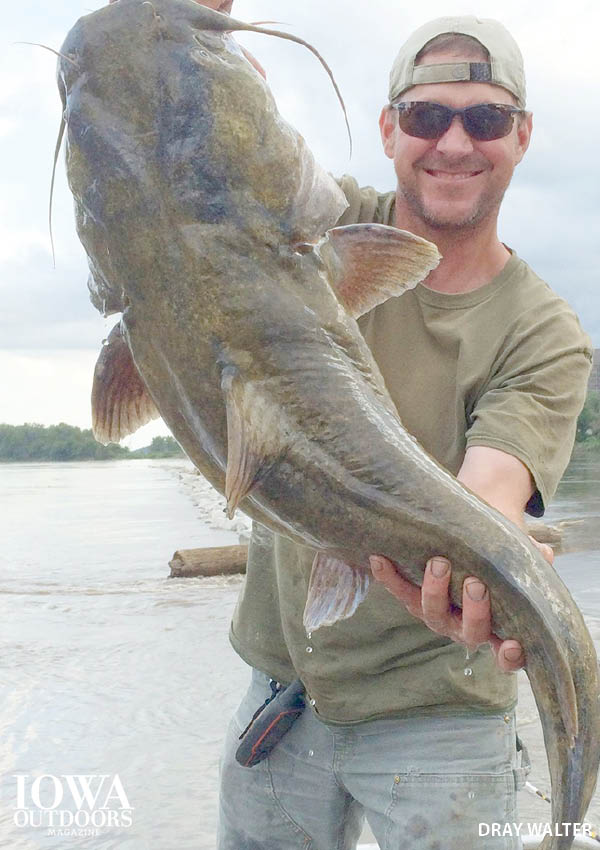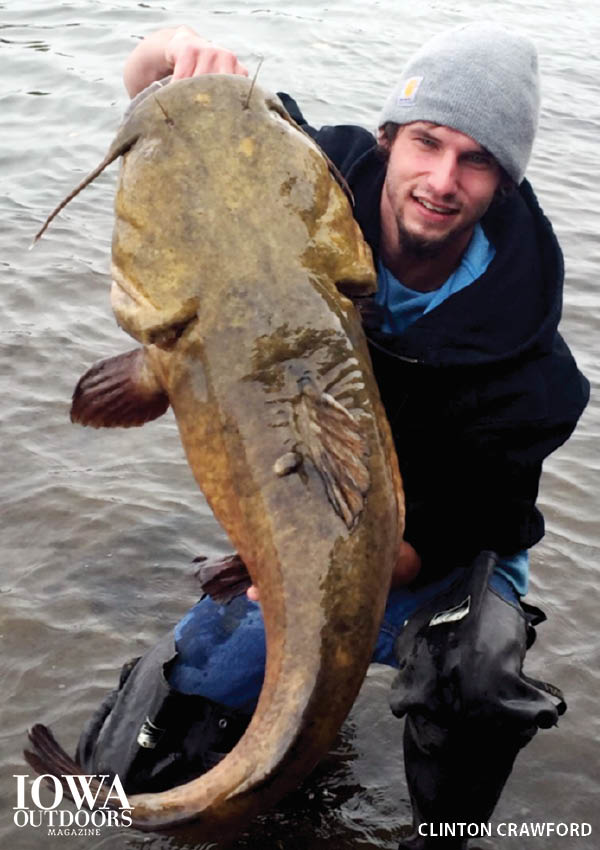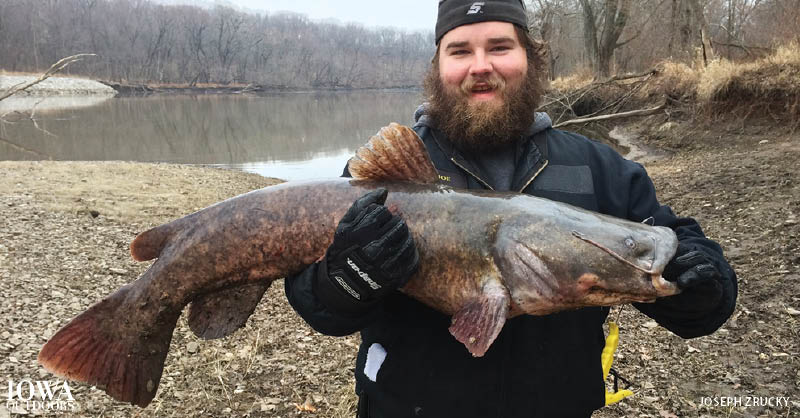From the May/June 2017 issue of Iowa Outdoors magazine
Subscribe now
They are the aquatic version of Count Dracula, quietly resting in the same dark, hidden location by day, and prowling for living prey by night. And like a vampire, they are legendary for both their great physical strength and ability to achieve a ripe old age. These “freshwater freight trains” require fishing tackle usually seen in saltwater situations, and can live at least 20 to 25 years.
The flathead catfish, Pylodictis olivaris, is known by other nicknames, most notably yellow catfish or mud catfish. And owing to a broad, flattened head (that seemingly comprises half their slender bodies), shovelhead catfish is yet another common nickname. They are fascinating in a way that is inversely-proportional to their looks.
 According to Dakota Sioux legend, a pod of catfish plotted to ambush and eat a moose as he waded into a lake. The attack ultimately failed, and the moose was so angered that he retaliated and trampled all the catfish’s heads flat. To this day, the catfish have flat heads as a result of the war the moose waged upon their grandfathers.
According to Dakota Sioux legend, a pod of catfish plotted to ambush and eat a moose as he waded into a lake. The attack ultimately failed, and the moose was so angered that he retaliated and trampled all the catfish’s heads flat. To this day, the catfish have flat heads as a result of the war the moose waged upon their grandfathers.
Formally described to science by Rafinesque in 1818, Pylodictis is Greek for “mud fish,” and olivaris is Latin for “olive-colored.” Flatheads are the only species in their genus, and appear unchanged from the middle Miocene epoch 15 million years ago. They have a protruding lower jaw, and in all but the very largest specimens, there is a pale whitish or cream-colored tip on the upper lobe of their tails.
The flathead is native to the Gulf of Mexico drainages, from the Mobile River basin over to the vast Mississippi River basin, on to the Rio Grande and from there well south into eastern Mexico.
As an apex predator, they are the schoolyard bullies within waters they inhabit. Live fish are their favorite prey, with smaller catfish and sunfish turning up in their bellies at especially frequent rates. And unlike other catfish species which readily scavenge, the predatory flathead prefers to consume its meal while it’s still kicking and screaming.
Depending on the latitude, spawning begins in late spring or early summer as the water begins warming into the mid-70s. A cavity is chosen in a hollow log, a hole in a riverbank, within riprap or sometimes even inside submerged cars and metal drums. After depositing her eggs, the female is driven away and the male aggressively guards the nest, fanning the egg mass with his fins to keep them aerated and sediment free. Upon hatching, the male continues his watch over the dense school of fry as they absorb their yolk sacs over the next few days, after which they begin dispersing to lead independent lives.
Young flatheads up to 4 inches are found among sandy, cobble-strewn riffle areas, consuming aquatic insect larvae. From about 4 to 12 inches, they are more generally dispersed throughout the stream environment, with crayfish and fish becoming an increasingly-important part of the diet. From about 12 to 16 inches, the fish are associated with cover at intermediate depths.
By the time they surpass 16 inches in length, flatheads are almost entirely piscivorous—fish eating—and very strongly associated with extensive cover such as logjams, downed trees, rootwads and jumbles of boulders found in deep pools with a slow to moderate current over a firm substrate.
The flathead is also something of a lone wolf: a single clump of cover will often yield only one, or at best just a few large individuals. The only exception is during the frigid water temperatures of winter, when dozens of these large individuals may congregate and overwinter among sheltered bottoms of deep pools.
And the word “large” really does apply. They rank among our biggest freshwater fish of any species, and are hot on the heels of the blue catfish as being our largest species of catfish, with a current national rod-and-reel flathead record of just over 123 pounds and an 81 pound, 52-inch monster caught in Iowa’s Lake Ellis in 1958. The minimum length to qualify for a DNR Master Angler Award is at least 35 inches. But unlike the somewhat-larger blue catfish, a decidedly “big water” fish of major rivers and huge reservoirs, the flathead can also be found in smaller streams, and for many anglers represent a more readily-available trophy fish that is closer to their doorsteps than the less-accessible blue catfish.
 Flatheads are a challenging quarry due not only to their sheer size and strength, but also because as a top predator, there are generally not many of them inhabiting a given location. Add to that their proclivity for live prey, strong homing instincts and chiefly nocturnal activity, and those elite anglers who can consistently land trophy-sized flatheads belong to a very select and skilled fraternity.
Flatheads are a challenging quarry due not only to their sheer size and strength, but also because as a top predator, there are generally not many of them inhabiting a given location. Add to that their proclivity for live prey, strong homing instincts and chiefly nocturnal activity, and those elite anglers who can consistently land trophy-sized flatheads belong to a very select and skilled fraternity.
Some folks feel that flatheads have a regular “milk run” of favored feeding routes and strategize their fishing in a manner much like a hunter plotting an ambush upon a wily trophy whitetail buck. The long intervals between bites can stretch from hours to nights, but to a flathead fanatic, patience finally pays off when setting the hook on what first seems to be a log, only to be quickly followed by an adrenaline rush and pounding heart when the “log” suddenly comes to life, turns and bulldozes away through the depths, rod bent to within a whisper of the breaking point and line tearing off the reel.
With a giant flathead, a successful battle is often fought to nearly a draw, with both fish and angler vanquished when the fish is finally beached. Few freshwater fish can rival a gigantic flathead when it comes to leaving the muscles in both arms, both legs and back strained and aching as you grunt and sweat to finally land them, and to a dedicated flathead angler this experience is simply euphoric.
The “Achilles heel” for this species is the vulnerability of the male while guarding the nest. In a technique known as “noodling,” the male is wrestled by hand onto the adjacent shore, which in turn dooms the eggs he had been guarding. Set lines are yet another method that can have an outsized impact on trophy flatheads. (Noodling for catfish is not allowed under Iowa fishing regulations).
Using circle-style hooks and encouraging catch-and-release can help conserve populations of trophy flatheads. As a further incentive not to kill and consume large flatheads, this long-lived and fish-eating species can accumulate contaminants in its flesh at greater levels than shorter-lived fish that feed lower in the food chain.
Sitting around a midnight campfire and gazing at the lazy swirls of murky current while pondering these mysterious creatures lurking somewhere below, and imagining instead oneself as the aquatic quarry of their nocturnal hunts, then the specter of a marauding predator cloaked by darkness represents a true living nightmare.
It’s an ancient anxiety conjured up from somewhere deep within—both primitive and palpable, of an apparition suddenly looming out of the blackness and devouring oneself—that makes the firelight and the flickering faces of family and friends all the more comforting in the wee hours of the night.
